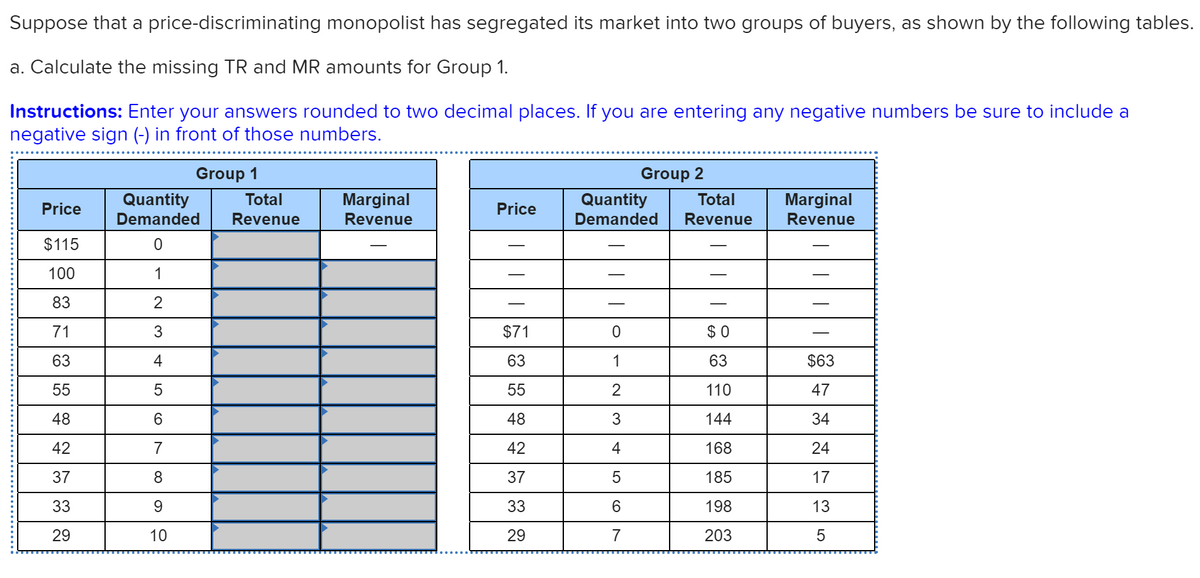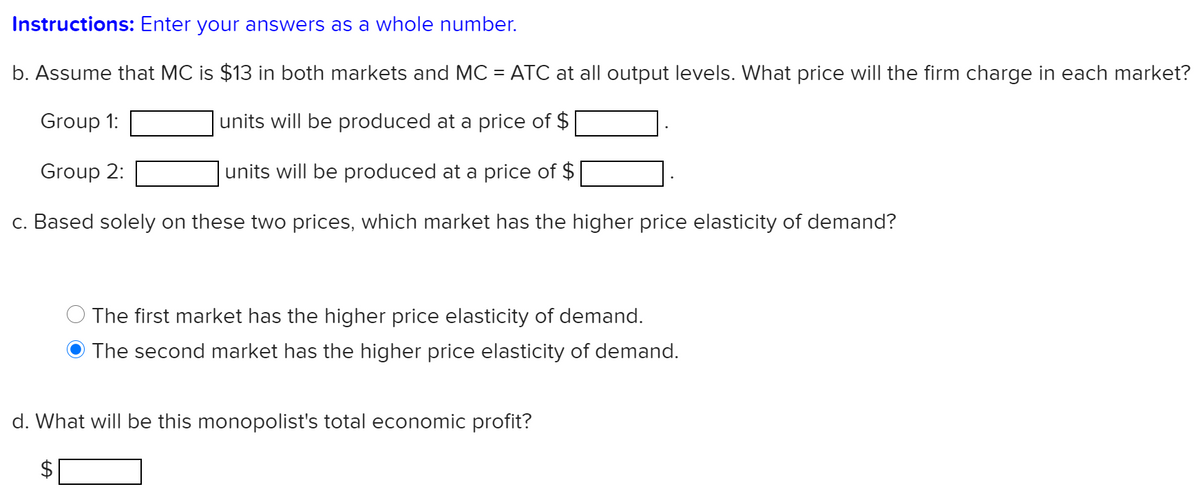Suppose that a price-discriminating monopolist has segregated its market into two groups of buyers, as shown by the following tables. a. Calculate the missing TR and MR amounts for Group 1. Instructions: Enter your answers rounded to two decimal places. If you are entering any negative numbers be sure to include a negative sign (-) in front of those numbers. Group 1 Group 2 Quantity Demanded Total Marginal Quantity Demanded Marginal Revenue Total Price Price Revenue Revenue Revenue $115 100 1 - 83 2 71 3 $71 $ 0 63 63 1 63 $63 55 55 2 110 47 48 6 48 3 144 34 42 7 42 168 24 37 8 37 5 185 17 33 9. 33 198 13 29 10 29 7 203
Suppose that a price-discriminating monopolist has segregated its market into two groups of buyers, as shown by the following tables. a. Calculate the missing TR and MR amounts for Group 1. Instructions: Enter your answers rounded to two decimal places. If you are entering any negative numbers be sure to include a negative sign (-) in front of those numbers. Group 1 Group 2 Quantity Demanded Total Marginal Quantity Demanded Marginal Revenue Total Price Price Revenue Revenue Revenue $115 100 1 - 83 2 71 3 $71 $ 0 63 63 1 63 $63 55 55 2 110 47 48 6 48 3 144 34 42 7 42 168 24 37 8 37 5 185 17 33 9. 33 198 13 29 10 29 7 203
Financial Reporting, Financial Statement Analysis and Valuation
8th Edition
ISBN:9781285190907
Author:James M. Wahlen, Stephen P. Baginski, Mark Bradshaw
Publisher:James M. Wahlen, Stephen P. Baginski, Mark Bradshaw
Chapter10: Forecasting Financial Statement
Section: Chapter Questions
Problem 4QE: Suppose you are analyzing a firm that is successfully executing a strategy that differentiates its...
Related questions
Question
100%

Transcribed Image Text:Suppose that a price-discriminating monopolist has segregated its market into two groups of buyers, as shown by the following tables.
a. Calculate the missing TR and MR amounts for Group 1.
Instructions: Enter your answers rounded to two decimal places. If you are entering any negative numbers be sure to include a
negative sign (-) in front of those numbers.
Group 1
Group 2
Total
Marginal
Revenue
Quantity
Total
Quantity
Demanded
Marginal
Revenue
Price
Price
Revenue
Demanded
Revenue
$115
100
1
83
71
3
$71
$ 0
63
4
63
1
63
$63
55
55
2
110
47
48
6.
48
144
34
42
7
42
4
168
24
37
8
37
185
17
33
9.
33
6.
198
13
29
10
29
7
203

Transcribed Image Text:Instructions: Enter your answers as a whole number.
b. Assume that MC is $13 in both markets and MC = ATC at all output levels. What price will the firm charge in each market?
Group 1:
units will be produced at a price of $
Group 2:
units will be produced at a price of $
c. Based solely on these two prices, which market has the higher price elasticity of demand?
The first market has the higher price elasticity of demand.
The second market has the higher price elasticity of demand.
d. What will be this monopolist's total economic profit?
%24
Expert Solution
This question has been solved!
Explore an expertly crafted, step-by-step solution for a thorough understanding of key concepts.
This is a popular solution!
Trending now
This is a popular solution!
Step by step
Solved in 5 steps

Knowledge Booster
Learn more about
Need a deep-dive on the concept behind this application? Look no further. Learn more about this topic, accounting and related others by exploring similar questions and additional content below.Recommended textbooks for you

Financial Reporting, Financial Statement Analysis…
Finance
ISBN:
9781285190907
Author:
James M. Wahlen, Stephen P. Baginski, Mark Bradshaw
Publisher:
Cengage Learning

Financial Reporting, Financial Statement Analysis…
Finance
ISBN:
9781285190907
Author:
James M. Wahlen, Stephen P. Baginski, Mark Bradshaw
Publisher:
Cengage Learning